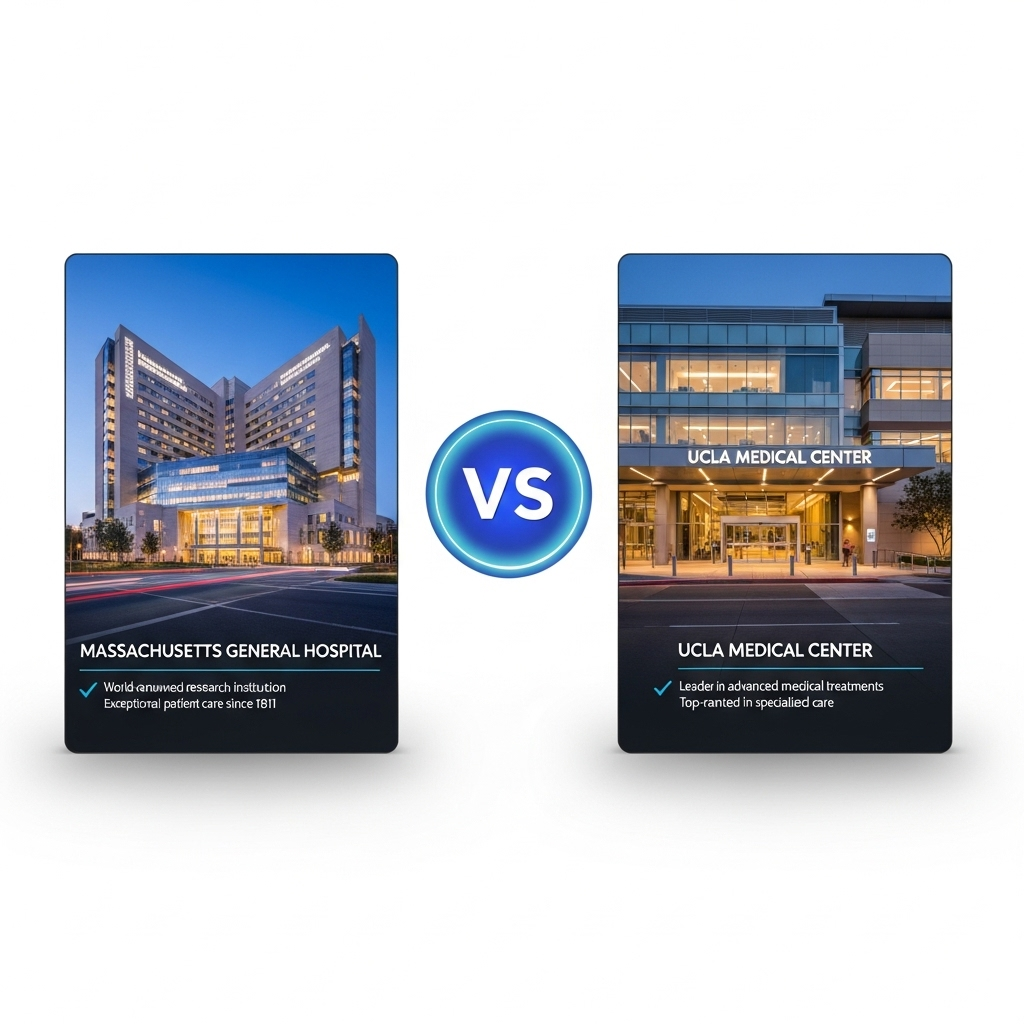Hospitals: Massachusetts General Hospital vs. UCLA Medical Center
Quick Verdict
Both Massachusetts General Hospital and UCLA Medical Center are excellent hospitals with strengths in different areas. The best choice depends on individual needs and priorities.
- Both hospitals are highly ranked teaching hospitals with strong research programs.
- Massachusetts General Hospital has a higher reported patient experience rating, but also reports longer ER wait times.
- UCLA Medical Center is recognized for patient satisfaction in Los Angeles and offers advanced technologies.

Key features – Side-by-Side
| Attribute | Massachusetts General Hospital | UCLA Medical Center |
|---|---|---|
| Location | 55 Fruit Street, Boston, Massachusetts | 757 Westwood Plaza, Los Angeles, CA 90095 |
| Teaching Hospital | Yes, Harvard Medical School/Harvard University | Yes, David Geffen School of Medicine at UCLA |
| Number of Beds | 999 (reports vary) | Varies by facility (520, 131, 74, 281) |
| Trauma Center | Level I Adult and Pediatric | Not explicitly stated |
| Research Activity | World's largest hospital-based research program, $1.2 billion in 2021 | Academic health center, access to new therapies and clinical trials |
| Overall Hospital Rating (CMS) | 5/5 stars | Overall star rating from Medicare.gov |
| Patient Experience Rating | 84% (18% higher than national average) | 13% higher than the national average (Ronald Reagan UCLA Medical Center) |
| Emergency Room Wait Times | Long wait times due to overcrowding | 2-6 hours for non-life-threatening conditions |
Overall Comparison
Rankings: Both Top Tier; Patient Experience: Similar; ER Wait Times: UCLA better
Pros and Cons
Massachusetts General Hospital
Pros:
- Recognized for doctor and nurse communication
- Recognized for hospital cleanliness
- High likelihood to recommend (94%)
- Magnet status for nursing excellence
- Recognized for meritorious outcomes in surgical patient care
- Outstanding Patient Experience Award™
- Surgical Care Excellence Award™
- America's 250 Best Hospitals Award™
Cons:
- Long wait times in the emergency department due to overcrowding
- Overall Customer Satisfaction score of 52
UCLA Medical Center
Pros:
- Top hospital in Los Angeles for patient satisfaction
- Recognized for patient-centered communication
- Actively working to reduce hospital-acquired infections
- Offers advanced technologies like robotic surgery and advanced imaging
- Access to new therapies and clinical trials
Cons:
- Emergency room wait times can be lengthy
- Disparities in infection rates among different racial/ethnic groups
User Experiences and Feedback
Massachusetts General Hospital
What Users Love
- Good communication from doctors and nurses
- Cleanliness of facilities
- Effective discharge planning process and instructions
- Concerns addressed promptly and effectively
Common Complaints
- Emergency room wait times are longer than normal
Value Perception
- No value feedback reported.
User Recommendations
- 94% of those who have used its services would recommend it to others.
UCLA Medical Center
What Users Love
- High patient satisfaction scores
- Recognized for patient-centered communication
- Cleanliness of the hospital environment is a factor in patient experience ratings
Common Complaints
- Emergency room wait times can be lengthy
- Potential issues with pain management
- Limited information about food and nutritional services
- Limited information about ease of navigation
Value Perception
- Access to advanced medical technologies
- Wide range of insurance plans accepted
- Access to new therapies and clinical trials
User Recommendations
- Ronald Reagan UCLA Medical Center was the top hospital in Los Angeles for patient satisfaction based on HCAHPS survey data.
- In 2024, Ronald Reagan UCLA Medical Center's patient experience rating was 13% higher than the national average.